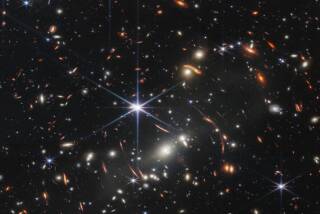Structure Is Largest Yet Seen in Universe : Astronomy: A newly discovered sheet of galaxies stretches for 500 million light-years. Harvard scientists call their discovery the Great Wall.
Scientists have discovered the largest structure seen so far in the universe, a narrow sheet of galaxies stretching more than half a billion light years across space.
The scientists, who have pioneered in the effort to determine the large-scale structure of the universe by creating three-dimensional images of space, have called their discovery the Great Wall.
Margaret Geller and John Huchra of the Harvard-Smithsonian Center for Astrophysics in Cambridge said the string of galaxies is 500 million light-years long, 200 million light-years wide, and about 15 million light-years thick. (A light-year is the distance light travels in a year, about 6 trillion miles.) They reported their discovery in today’s issue of the journal Science.
The Great Wall is more than 200 million light-years away from Earth, and it cannot be seen with the unaided eye. In fact, it does not even show up in normal astronomical photographs because it is revealed only through a three-dimensional effect.
Geller and Huchra are engaged in an ambitious research project that has revolutionized the thinking on the shape of outer space. By measuring the distance between Earth and 10,000 galaxies in a pie-shaped wedge of the northern celestial hemisphere, they have been able to plot the galaxies with a computer and they have produced some startling results.
Four years ago they announced that their first three-dimensional image revealed that the universe is structured around giant voids that look somewhat like soap bubbles in a dishpan. Galaxies are strung along the skin of the “bubbles,” and scientists have debated fiercely over how the bubbles could have been created.
Some of the bubbles are huge, measuring 150 million light-years in diameter. That is so big that scientists are at a loss to explain how the matter that makes up galaxies could have been swept clear of such a large area in the 10 to 20 billion years since the universe was born.
Early explanations, including the suggestion that massive explosions sent matter flying out from the center of the voids to create the bubble effect, have not gained acceptance because scientists cannot explain how matter could have traveled far enough to create the giant voids in the lifetime of the universe.
Today’s announcement only adds to the mystery and was described by the two scientists as “one of the most sobering results” of their research.
It may well be that there are even much larger structures waiting to be discovered, further complicating the lives of cosmologists who are already struggling to explain why the universe should have enormous areas that are devoid of galaxies.
“The size of the largest structures we detect is limited only by the extent of the survey,” Geller said.
Although earlier attempts to determine the structure of the universe suggested in the 1970s that space had some areas that were devoid of galaxies, Geller and Huchra were the first to carry the surveys far enough into space to see the large-scale structures, including the bubbles and the Great Wall.
They have used the 60-inch telescope at the Smithsonian’s Whipple Observatory on Mt. Hopkins, Ariz., to measure the “red shift” of galaxies in a pie-shaped “slice of the universe.” As a galaxy speeds away from the Earth, the light it emits is shifted to the red end of the electromagnetic spectrum. By measuring the red shift, the scientists are able to determine the distance to the galaxies.
The first results suggested that voids were present. Subsequent surveys, looking twice as far into space as previous efforts, revealed that the patterns continued farther out.
The Great Wall became a distinct structure as the scientists finished their fourth “slice of the universe.”





